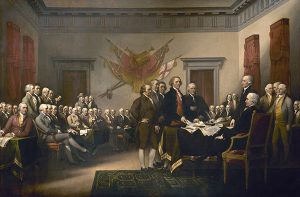DISCUSSION No. 3.1: U.S. Constitution and Founding
Slavery and the Constitution – an inevitable choice?

Credit (image at right): slave auction – C. 1877 engraving – Library of Congress and Dolph Briscoe Center for American History, University of Texas at Austin
The questions below will be discussed in class on Tuesday, but you must also post answers here on Canvas. Come to class prepared to answer QUESTION 1 by reading Chapter 2 in our textbook, especially pages 44-46, and thinking about the choices the Founders were faced with. Also, answer QUESTION 2 after reading two or more of the short essays by scholars who have debated these questions. ANSWERS due Monday, REPLIES to 2 other students due Wednesday. (Remember the Rubric!)
QUESTION 1. Some observers of the Philadelphia Convention argue that the authors of the Constitution failed their country by failing to outlaw slavery in 1787. Others claim that the Constitution would never have been ratified if slavery had not remained legal. What do you think? Did the framers of the Constitution fail or did they do the best they could, given the circumstances? Were there other alternatives they could have explored? Explain your reasoning.
_________________________________________________
After answering Question 1 above, read two or more of the short essays by scholars who debated this question in a NY Times piece in 2013: https://www.nytimes.com/roomfordebate/2013/02/26/the-constitutions-immoral-compromiseLinks to an external site.. Then answer the following question:
QUESTION 2. Do ideas expressed in these essays change how you think about your answers above? Why or why not?
Here are some excerpts from 3 of the essays:
Prof. Leslie M. Harris, Emory University: “Had the Constitutional Convention forced the hand of the Southern colonies by denying the three-fifths compromise, could North and South have existed as separate nations? * * * In the United States, the decision to empower the slave-holding South via the three-fifths compromise — and it was a decision — led to the enslavement of over 4 million blacks by the time of the Civil War; the loss of as many as 750,000 lives during the Civil War; and the development of a racism that oppressed the opportunities of many millions more Americans of African descent long after slavery’s end.”
Prof. Paul Finkelman, Albany Law School: “The Northern nation, free of bondage and southern hostility to internal improvements, would have used the national power to build canals, a national university system, banks, railroads and a powerful economic infrastructure. A great northern United States would have emerged, alongside a decadent slave-owning plantation culture economically dependent on its northern neighbor.”
Prof. Sanford Levinson, University of Texas Law School: “There was justified fear that the dissolution of the existing United States would, as in Europe, lead to endless warfare among the two or three separate countries, which would inevitably enter into ‘entangling alliances’ with European powers eager to work their will in the ‘New World.'”
DISCUSSION No. 3.2: Federalism Today – key issues about the state-federal balance of power
Federalism Today – key issues about the state-federal balance
Post your ANSWERS to the questions below by Wednesday (10 points), and REPLY to 2 other students’ answers by Friday (5 points). Come to class Thursday prepared to discuss your answers.
- Federalism was an outgrowth from how the US government was created under the Constitution. What is your understanding of federalism and why it exists?
Using your understanding of federalism, CHOOSE ONE of the 2 issues below (A or B), read the selected article and analyze the federalism issue by answering Questions 2-5. (Clearly identify whether you’re answering issue A or B.)
A. Dobbs decision and state abortion laws https://www.discoursemagazine.com/ideas/2022/06/24/federalism-has-its-limits-and-abortion-will-soon-test-them/Links to an external site.
B. Respect for Marriage Act https://www.npr.org/2022/12/08/1140808263/what-does-the-respect-for-marriage-act-do-the-answer-will-vary-by-stateLinks to an external site.
2. Explain what the tension is between state and federal control on this issue, and why that tension exists.
3. Does the balance of power seem to be tipping more in favor of the states or the federal government on this issue? Why? What would need to happen for it to tip back in the opposite direction?
4. Do you think this issue would be best resolved with more state control or more federal control? Why?
5. Identify any marginalized community(ies) being affected by this issue and explain how they are being affected.




